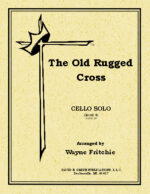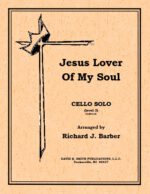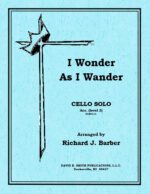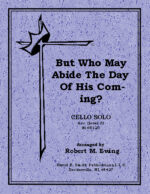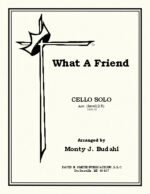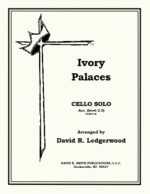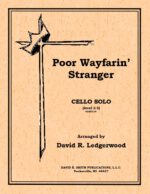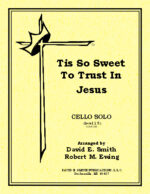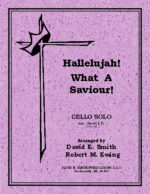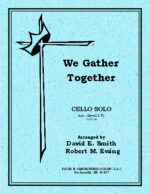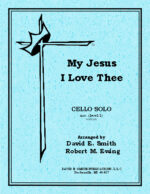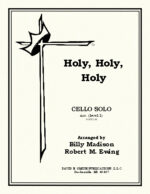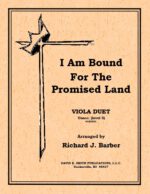-
The Old Rugged Cross
$5.00This cello solo begins with a flowing-like accompaniment and is then joined with a somewhat straight forward rendition of the traditional tune in the solo line. As it progresses it becomes more and more embellished. After a brief interlude by the accompaniment the solos continues in a highly embellished manner. While the piece is obviously technical it gives the skilled player an opportunity to display a lot of expression and add to the meaning of the hymn.
-
Saviour Like A Shepherd
$4.50This cello solo begins with a simply stated introduction in the piano with the solo line presented verbatim, the original tune. The middle section melody is in the piano with the soloist giving a lilting countermelody making for a pleasing interaction of the two parts. The third section reverts back to the structure of the opening concluding with richer harmonies and settling with a solid statement in the solo while support with a motivic statement in the piano.
-
I Wonder As I Wander
$4.50This cello solo starts out with piano motive that will be used throughout the piece and is then joined with the solo using the last phrase of the song. The next section uses the tune pretty much in its original form with the piano adding various arpeggios and thematic motives. The piano then presents a flowing version of the song while the soloist adds a idiomatic obbligato… then the final section has the soloist presenting the melody while the piano punctuates an underlying accompaniment. The coda section is much like the introduction and the soloist gives one final thematic motive.
-
But Whom May Abide The Day…
$6.50Taken from the “Messiah”, this solo with piano is essentially a transcription of the original work. It features sufficient counterpoint between the various instruments.
-
What A Friend
$4.00A solo that begins with a brief introduction in the piano. The soloists then presents the tune in a straight-forward rendition. The second section presents the tune in the piano while the soloist overlays with a gentle obligato. The third section goes back to the melody briefly and then shifts back to the obligato and then settles into a final repose.
-
Ivory Palaces
$4.00A Cello solo stating the melody in a straight forward fashion with an accompaniment that is gentle and constantly moving. The second section presents the thematic material in the piano with a motivic overlay in the solo line. The final section is fashioned much like the first section The Coda is a gentle motif of the theme ending is a sweet repose.
-
Poor Wayfarin’ Stranger
$4.00This cello solo is a solemn, expressive piece from beginning to end where the melody is in the solo line. In the middle section the piano presents the tune while the solo line uses the counterline that was used previously by the piano.
-
Young Cello Soloist
$13.95A solo collection with piano including: “Praise Him All Ye Little Children,” “Abide With Me,” “Dare To Be A Daniel,” “My Jesus I Love Thee,” “Away In A Manger,” “We Gather Together,” ” “Hallelujah! What A Saviour,” and “‘Tis So Sweet To Trust In Jesus.”
-
Tis So Sweet to Trust in Jesus
$3.75This solo with piano is structured in a quasi-rondo form. Thus making a great deal of variety in texture, style, and dynamic.It will make the young performer sound more advanced. The arrangement is edited with bowing and fingering
-
Hallelujah! What A Saviour!
$3.75This solo with piano follows a simple theme and variation form. It gives the young soloist the opportunity to play many styles in a short framework.The arrangement is edited with bowing and fingering marks.
-
Away In A Manger
$3.75This solo with piano begins with the portrayal of a pastoral setting. The arrangement incorporates both “Flow Gently Sweet Afton” and “Luther’s Hymn”.The arrangement is edited with bowing and fingering marks.
-
We Gather Together
$3.75This solo with piano makes a straight forward statement of the tune followed by a contrasting section using a new counter melody. It then returns to the opening theme. The arrangement is edited with bowing and fingering.
-
Dare To Be A Daniel
$3.75This solo with piano begins with the strains of a lion’s roar. Next enters Daniel in a simple fashion followed by a statement in a triumphal march. The lions return-Daniel prevails. The arrangement is edited with bowing and fingering marks.
-
Praise Him All Ye Little Children
$3.75This solo with piano begins with a bold march statement with an elongated rhythm of the melody. The middle section is more expressive while the final section imitates the beginning. The arrangement is edited with bowing and fingering
-
Abide With Me
$3.75This solo piece with piano is presented in a straight-forward manner for the younger player with some altered pitches for interest. The arrangement is edited with bowing and fingering marks.
-
My Jesus I Love Thee
$3.75This solo with piano begins with a modified melodic statement. It enters into a second section with simple obligati and then returns to a beginning-like statement and ends with a simple coda. The arrangement is edited with bowing and fingering
-
For The Beauty Of The Earth
$3.75This solo with piano begins with a simple statement of the tune with a middle section that uses motivic design, only to return to the opening statement.The arrangement is edited with bowing and fingering marks.
-
Holy, Holy, Holy
$3.75This solo with piano is straight forward in design, giving the young player the opportunity to display dynamic and stylistic variety.The arrangement is edited with bowing and fingering
-
-
Channels Only
$5.00A Viola duet beginning with a motivic introduction followed by part one presenting a modified melody with part two using a moving countermelody. The next phrase the roles are reversed. Next a modulation occurs and the melodic material is much like the first verse followed my another modulation. The coda section is much like the introduction only this time in a different meter and concludes in a simplistic fashion.
-
The Old Rugged Cross
$5.00This viola solo begins with a flowing-like accompaniment and is then joined with a somewhat straight forward rendition of the traditional tune in the solo line. As it progresses it becomes more and more embellished. After a brief interlude by the accompaniment the solos continues in a highly embellished manner. While the piece is obviously technical it gives the skilled player an opportunity to display a lot of expression and add to the meaning of the hymn.

